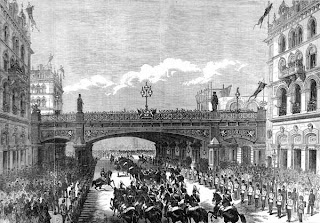London’s “lost” rivers
Chelsea’s football ground
should be called Counter’s Creek not Stamford Bridge – the creek which starts
at Kensal Green and flows underground through Olympia and Earls Court ends at
Sands End where it flows out into the Thames. Someone got confused when it was
named and thought the Thames tributary was Stamford Brook. Counters Creek is
one of the many “lost” waterways of London.
Look out for names to give
clues as to what lies beneath.
 |
| Route of river Westbourne 1790 |
- Spring Grove
- Well Walk
- Brook Green
- Kilburn
- Westbourne Park
- Knightsbridge
There was a time when London’s rivers were not lost but the source of fish and provided transport and energy.
The Domesday Book in 1086 records more than 6,000 mills and freshwater fisheries on the capital's rivers, streams and brooks.
By medieval times many had become dumping grounds for rubbish and sewage, causing blocked channels to flood and had generally become "an eye-sore and a nose-sore".
Nicholas Barton author of the Lost Rivers of London describes how the biggest of London’s rivers - the Fleet - was partly covered over during the rebuilding of the city after the Great Fire in 1666, and finally after the Great Stink of 1858, when London was choked by the smell of the Thames.
Holborn Viaduct
Although this is now is a road bridge linking Holborn with Newgate Street in the City of London, passing over Farringdon Street it also crosses a 'lost' river.
 |
| Holborn Viaduct |
It was built between 1863 and 1869 and replaced a much older structure; Holborn Bridge,
which crossed the River Fleet already culverted to the Thames a century earlier.
This shows a royal procession under Holborn Viaduct in 1869 and along the road covering the river Fleet.
An unsung hero
Sir Joseph Bazalgette was commissioned by the Metropolitan Board of Works to set up a new
underground sewage system which as well as reducing the stink had the unexpected effect of saving many lives
of people who might have died from cholera contracted from London’s drinking
water. Bazalgette’s system incorporated several rivers during the 19th century,
including the Tyburn.
The water and sewerage system included several pumping stations such as the decorative Octagon at Crossness near Erith Marshes.
Mind the pipe
Although most of these rivers have gone underground and are part of the water drainage and sewerage systems of London – some are channelled through pipes and can be seen above ground.
Not just shopping but fishing
Even though the rivers have been lost to sight they have not been forgotten. Today enthusiasts of London’s underground rivers include The Tyburn Angling Society whose architect envisages a return to rivers overground and a series of pools and canals suitable for anglers.
An unsung hero
 |
| Sir Joseph Bazalgette |
 |
| The Octagon pumping station |
The building may look familiar to video game players who reached the final mission of the video game The Getaway: Black Monday. This was the building used for the video.
Mind the pipe
 |
Although most of these rivers have gone underground and are part of the water drainage and sewerage systems of London – some are channelled through pipes and can be seen above ground.
Here the river Westbourne flows through a conduit at Sloan Square tube station.
Not just shopping but fishing
Even though the rivers have been lost to sight they have not been forgotten. Today enthusiasts of London’s underground rivers include The Tyburn Angling Society whose architect envisages a return to rivers overground and a series of pools and canals suitable for anglers.
My idea for this blog came from one of the excellent London Walks – Subterranean London. If you have a couple of hours to spare you can
learn a lot on one of their guided walks. Just turn up and pay the fee. No
booking required.

No comments:
Post a Comment